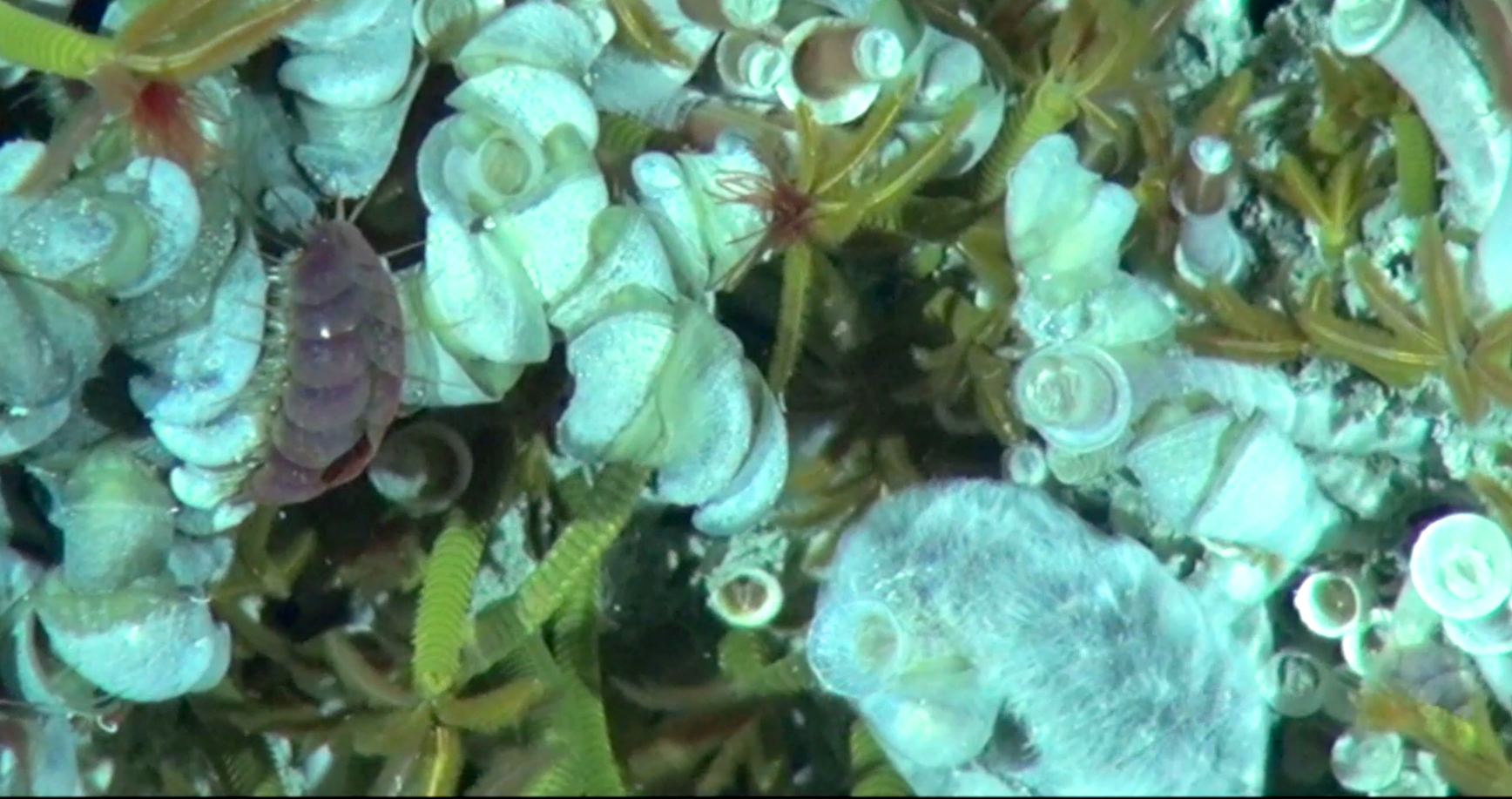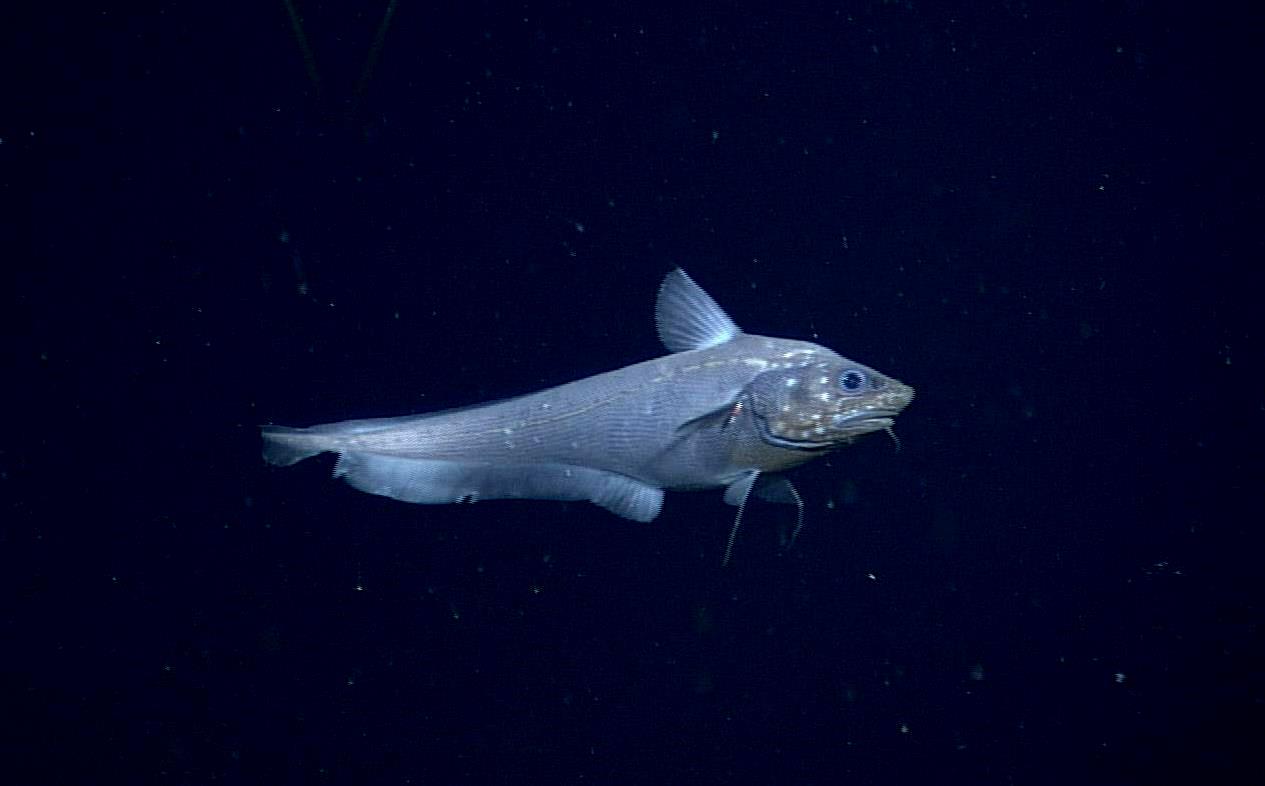Image Archive



























Seastars (Class Asteroidea) and Brittle Stars (Class Ophiuroidea) belong to Phylum Echinodermata. Photo credit: NSF-OOI/UW/CSSF; Dive R1727; V14

Brittle stars (Ophiuroids) are found everywhere on Axial. This species (center) may be different from the much more common Spinophiura jolliveti. Photo credit: NSF-OOI/UW/CSSF; Dive R1727; V14

This Deep-Sea cucumber (Holothurian) is likely of the genus Pannychia, possibly Pannychia moseleyi. Photo credit: NSF-OOI/UW/CSSF; Dive R1724; V14

Two scaleworms roam among the Palm worms and limpets at Mushroom, one of the hydrothermal vents at ASHES vent field on Axial Seamount. One worm shows its usual pinkish red color (at left), while the other is coated with a fur-like layer of filamentous bacteria. This image was taken with the RCA HD Video Camera during its test on the seafloor during VISIONS 13. Credit: UW/NSF-OOI, V14

ROCLS with 4.7 km of extension cable, which was laid on Axial, from Primary Node PN3B to the Central Caldera. Photo credit: Christina Ramirez, University of Washington, V14.

The broadband seismometer (left) and low frequency hydrophone (right) are installed on the floor of Axial Seamount at the Central Caldera Site. The 7-function manipulator of ROPOS is connecting the extension cable to the medium powered junction box. The white bags inssulate the broadband from acoustic "noise" associated with curents flowing over the instrument.

A holothurian Deep Sea Cucumber (possibly of Genus Pannychia) at 5000 ft is surrounded by brittle stars and a sea spider (bottom right). Photo credit: NSF-OOI/UW/CSSF; Dive R1727; V14.

Sea cucumbers (Phylum Echinoderm, Class Holothuria) are common in the sediments at the base of Axial Seamount. This one is an unknown species of the genus Peniagone. Photo credit: NSF-OOI/UW/CSSF; Dive R1715; V14

This Big Red Jelly (Tiburonia granrojo) seemed to be inspecting ROPOS' camera. Photo credit: NSF-OOI/UW/CSSF; V14

A Seastar on a sheet flow at Axial Seamount. Credit: UW/NSF-OOI/CSSF; ROPOS Dive R1724; V14.

This small sea cucumber (Holothurian) belongs to the Peniagone genus. It is common at the base of Axial. Photo credit: NSF-OOI/UW/CSSF; Dive R1714; V14

This small sea cucumber (Holothurian) belongs to the Peniagone genus. It is common at the base of Axial. Its undulating motion allows it to swim from place to place. Photo credit: NSF-OOI/UW/CSSF; Dive R1599; V13

This jellyfish looks something like a lampshade. Photo credit: NSF-OOI/UW/CSSF; Dive R1723; V14

Palm Worms inhabit the toxic waters of El Guapo hydrothermal vent on Axial Seamount. Photo credit: UW/NSF-OOI/CSSF; V11.

Palm Worms at top of El Guapo. Credit: UW/NSF-OOI/CSSF; V11.

A Cockatoo Squid swam by the ROV camera. Credit: UW/NSF-OOI/CSSF; ROPOS Dive R1712; V14.

This curious Cockatoo Squid (Taonius borealis) inspected the ROV ROPOS's camera. Credit: UW/NSF-OOI/CSSF; V13.

A Rattail Fish (Coryphaenoides acrolepis) is by far the most common fish on Axial. Credit: UW/NSF-OOI/CSSF; ROPOS Dive R1601; V13.

The Deep Sea Skate (Bathyraja abyssicola) is a fairly frequent visitor to Axial Seamount; Credit: UW/NSF-OOI/CSSF; V13.

A Rattail checks out the fiber optic cable at Axial Seamount. Credit: UW/NSF-OOI/CSSF; ROPOS Dive R1608; V13.

A Roughtail skate (Bathyraja trachura) resting near a vent on Axial Seamount. Credit: UW/NSF-OOI/CSSF; ROPOS Dive R1617; V13.

During Leg 1 of the OOI-NSF VISIONS'14 Expedition, we are making significant progress in the installation of secondary infrastructure at the summit of Axial Seamount. Infrastructure shown in green is deployed on the seafloor. During ROPOS Dive R1727, the ~ 4.6 km extension cable from PN3B to MJ03F at Central Caldera will be installed, completing this site. Image Credit: University of Washington, V14.

This deep sea, purple spiny sea urchin (possibly Tromikosoma panamense) was seen at the base of Axial. Photo credit: NSF-OOI/UW/CSSF; Dive R1715; V14

This unknown sea cucumber was found at the base of Axial Seamount, living among the brittle stars. Photo credit: NSF-OOI/UW/CSSF; Dive R1716; V14

This spiny Holothurian Deep-Sea Cucumber (possibly of Genus Pannychia) has been seen on many regions of Axial Seamount. Photo credit: NSF-OOI/UW/CSSF; V13

This large purple sea cucumber (Holothurian) was seen at the base of Axial Seamount, foraging through the sediments. This one is likely Paelopadites confundens. Photo credit: NSF-OOI/UW/CSSF; V14.

A current meter is held in the manipulator of the ROV ROPOS for installation at the International District 2 Site. Photo credit: NSF-OOI/UW/CSSF; Dive 1723; V14.

These small sea spiders are Pycnogonids (Phylum Arthropoda) and live among the tube worms and limpets on hydrothermal vents of Axial Seamount. Photo credit: NSF-OOI/UW/WHOI; V11
- Anemone
- Animal
- Arthropod
- ASHES
- Axial
- Axial Base
- Axial Biology
- Axial Caldera
- Bacteria
- Basalt Lava
- BEP
- Biofouling
- biolgoy
- Biology
- Camds
- Camera
- Camhd
- Central Caldera
- Ciliates
- Cnidaria
- Coastal Biology
- Crab
- Deep Profiler Mooring
- Dive Highlights
- Eastern Caldera
- Echinoderms
- Endurance Array
- Engineering Team
- ENLIGHTEN 10
- Exploratorium
- Fish
- Geology
- HD Camera
- HPIES
- Hydrate Ridge
- Hydrates
- Hydrophone
- Hydrothermal Vents
- Illustration
- Inshore 80 Meters
- Instrument
- International District
- J-BOX
- Jason
- Jellyfish
- Junction Box
- K12
- Lava
- Mollusk
- Moorings
- Nodes
- Nudibranch
- Octopus
- OOI
- Oregon Offshore
- Oregon Offshore 600 m
- Oregon Shelf
- Oregon Slope Base
- People
- PN1B
- PN1D
- Polychaetes
- PPSDN
- Primary Node
- RASFL
- ROCLS
- ROPOS
- ROPOS Dives
- ROV Team
- RV Revelle
- RV Sikuliaq
- RV Thompson
- Salp
- Sample
- SC13
- Science Team
- Sea Cucumber
- Sea Star
- Sea Urchin
- Seafloor
- Seismometer
- Sensors
- Shallow Profiler Mooring
- Shark
- Shipboard
- Shore Station
- Slope Base
- Smoker
- Soft Coral
- Southern Hydrate Ridge
- Sponge
- Squid
- Students
- Students & Guest Participants
- Tmpsf
- Tubeworms
- VISIONS 11 Leg 1
- VISIONS 11 Leg 2
- VISIONS 11 Viewers
- VISIONS 13
- VISIONS 14
- VISIONS 15
- VISIONS 16
- VISIONS 17
- VISIONS 18
- VISIONS 20
- VISIONS 22
- VISIONS 23
- Visualization
